Interviewed and Written by Patrick Mc Gavin 4/08
ROGER OLSEN ’39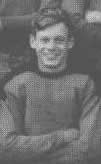
As a young man Roger Olsen witnessed the most significant historical acts of the 20th century. He lived through the Depression and served with distinction in the Pacific theater during the Second World War.
Reflecting on his life and varied past, Mr. Olsen did not hesitate to recall the period that profoundly shaped his life. It prepared him mentally, emotionally and intellectually for the demands placed on him as a young man.
His retains proud, spirited memories of his four years at Leo Catholic High. Mr. Olsen is a distinguished graduate of the class of 1939.
In ways both anecdotal and important, Mr. Olsen’s life embodies not only the spirit and tradition of the school. His experiences and colorful perspective provide an important early view of the school’s foundation, the importance of its curriculum and still vivid memories of his experiences playing football.
Parallel lives
Born in 1921 Mr. Olsen was only five-years old when the Christian Brothers of Ireland established their first Chicago school, Leo High at South Sangamon on East 79th Street . The oldest of four children and the only boy, Roger grew up in the Roseland area of 101st and Forrest. His father did not attend high school. “My father was a street-car conductor [who] worked hard all of his life,” Mr. Olsen says.
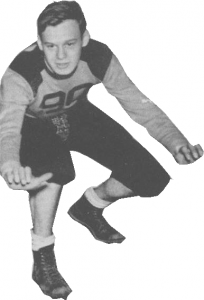 He learned from the father the meaning of hard work and effort. His mother also lacked a deep formal education. She was strong-willed and determined that her children receive a strong Catholic education. His mother knew school was the best and most effective means for success and the route to escape the severe economic restrictions of the time. Mr. Olsen was young and wide-eyed, but he knew instinctively that people were struggling greatly for the most basic of goods and services.
He learned from the father the meaning of hard work and effort. His mother also lacked a deep formal education. She was strong-willed and determined that her children receive a strong Catholic education. His mother knew school was the best and most effective means for success and the route to escape the severe economic restrictions of the time. Mr. Olsen was young and wide-eyed, but he knew instinctively that people were struggling greatly for the most basic of goods and services.
“We were fortunate that [my father] worked through the Depression. I realized what the Depression was because a lot of times we had relatives staying with us for a couple of weeks, family members who were in between jobs or just looking for work.”
“Tuition at Leo was $11 a month,” Mr. Olsen recalls, laughing, a good bit of money back then. His scholarship also provided for books and some traveling expenses.
He made the round trip by riding the State Street car to 79th before transferring to a second car that traveled west toward Sangamon . The moment he arrived at Leo, he realized how sheltered his life had been. “I remember my first day there; I met a fellow named Tom Burke. He was the biggest fellow I’d ever seen. I couldn’t believe how big he was.”
By contrast Mr. Olsen was tall and thin as wire. He was just over five-feet, ten-inches. He entered Leo weighing just 135 pounds.
His two closest childhood friends wound up at different schools. From the start, Mr. Olsen felt accepted at Leo. In his new environment, he quickly found his stride and felt immediately apart of a school, a community and a group order that privileged learning, discipline and structure. The Brothers’ primary mission was education, and the school’s rigorous academic mandated math, science, Latin, English and social sciences.
The school also promoted athletics, with its team concepts and its emphasis on the intrinsic values of dedication, sportsmanship, competition and physical development. The balance of academics and athletics proved a blessing, and it helped him find his voice and be a part of something.
“I was very self-motivated. I wanted to play football.”
From the time of its founding, Leo competed in the Chicago Catholic League. In 1934, the year before Mr. Olsen entered the school, Leo qualified for its inaugural Prep Bowl. That appearance would presage the start of a remarkable run by the school. Leo qualified for the Prep Bowl an astounding eight times from 1934 to 1956.
appearance would presage the start of a remarkable run by the school. Leo qualified for the Prep Bowl an astounding eight times from 1934 to 1956.
Mr. Olsen always loved football. In grammar school, he’d play with his best friends in sandlots and at parks. They were so enthusiastic they played in overalls without helmets or pads. He was so skinny he did not try out for the team as a freshman. In his sophomore year, he played in the younger, lightweight division. Little did he know, by his junior year he’d be part of history.
Origins
Football was a much different game then. The nature and style of play was fairly rudimentary and straightforward. The National Football League was in its early stages. College football was the national rage. That was the story locally, as well. The University of Chicago , with star running back Jay Berwanger, was a big-time program. In 1935, Berwanger won the first ever Heisman Trophy and he was the first player ever drafted in the NFL. As a schoolboy about to enter Leo, Mr. Olsen used to listen raptly to radio broadcasts of Berwanger’s accomplishments.
Entering the second decade of its existence, Leo had an avid following. The home games typically attracted up to eight thousand fans. The formation of the Catholic League produced 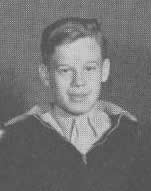 strong rivalries that intensified the drama. “Our biggest rival was Mount Carmel . I’m not sure what to attribute that to, but I guess it was just two schools that had a lot of decent athletes,” Mr. Olsen says.
strong rivalries that intensified the drama. “Our biggest rival was Mount Carmel . I’m not sure what to attribute that to, but I guess it was just two schools that had a lot of decent athletes,” Mr. Olsen says.
By his junior year, Mr. Olsen was one of 54 Lions that made up the varsity squad. The coach, Whitey Cronin, was a formidable figure. “He was a dandy, a tough but a very fair coach,” he says. Motivation was almost completely unnecessary. The young men at Leo were determined to achieve success. Coach Cronin was the avenue to that path.
Back then the rules of the game favored running. “In those days if you had two incomplete passes [on consecutive plays], you’d get a five-yard penalty.
“Our primary formation was called the Short Punt,” Mr. Olsen says. “We were always in a punt formation, but the tailback was closer to the line of scrimmage.” Punting was a strategic ploy where teams punted in order to achieve strategic power and improve field position.
The 1937 season began somewhat inauspiciously with a 7-6 practice loss to Loyola. The team quickly regrouped and asserted its dominance. The Lions hammered Columbia 30-6 and ousted rival Mount Carmel 14-6. After whipping St. Phillips and St. Ignatius in consecutive games, the Lions revealed their mettle against St. Rita.
Leo fought off two big deficits, down 14-7 at the half and 20-7 after three periods. Leo scored two touchdowns in the fourth quarter for the riveting 21-20 victory. Leo beat De La Salle 22-6 in front of a home crowd of more than 13,000. They ended the regular season by defeating a strong Joliet Catholic team in the mud and rain 12-6.
In the Catholic League playoffs, Leo easily dispatched St. George and qualified for the Prep Bowl. Playing Public League power Austin , the game entered history when the largest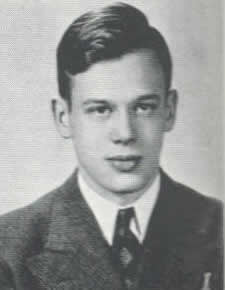 crowd to ever watch a football game, estimated at 113,000, poured into Soldier Field.
crowd to ever watch a football game, estimated at 113,000, poured into Soldier Field.
Austin stole some thunder of the Lions’ remarkable season by winning the game. Even so, Leo’s place in Chicago high school football history was secure. The team finished 8-2. Mr. Olsen was a reserve, but he got into every game. There was not as much substitution because of a rule that prevented a substituted player from re-entering a game in that quarter.
In his senior year of 1938, Mr. Olsen played more regularly. That team was not quite at the level of his junior year. They finished with a 6-3-1 mark.
After Leo
Following his graduation in 1939, Mr. Olsen studied mechanical engineering at the Illinois Institute of Technology. During his first year the school was called Armour. He entered there on a work and academic co-opt. He worked eight weeks at a time and studied the next two months.
In 1944, he earned a Navy commission. Following his basic training in New York , Mr. Olsen was a landing track officer on an attack transport (APA) for assault operations in the Pacific. Three weeks before he entered the Navy, he married Genevieve McCormick. “I’d been courting her for about five years,” he says. “Our first date was the senior prom.
”Honorably discharged from the Navy in 1946, Mr. Olsen worked as a mechanical engineer at a Chicago architectural company. He also worked in sales. His primary corporate experience was at Peoples Gas, where he worked for nearly 30 years. He and his wife had five children. Mr. Olsen has 11 grandchildren and six great-grandchildren.
After living in South Holland for nearly five decades, Mr. Olsen returned to city. He lives in a condominium in the South Loop . “My wife and I always talked about moving back to the city. We were city kids. That’s the only thing I regret about her not being here,” he says. His primary hobby now is golf, which he plays regularly.
The Leo emphasis on discipline, character and tolerance was the defining experience of his varied and purposeful life. Being part of Leo indelibly stamped Mr. Olsen for the rest of his life.
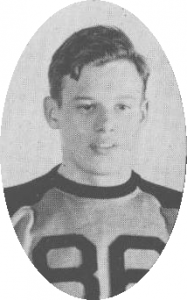 “Thinking about it, I had great memories playing football. I really enjoyed my time at Leo, especially the learning and the association with the Brothers. My time at Leo definitely helped me in college. I learned how to study, which was obviously very important.
“Thinking about it, I had great memories playing football. I really enjoyed my time at Leo, especially the learning and the association with the Brothers. My time at Leo definitely helped me in college. I learned how to study, which was obviously very important.
He paused. There was not much more to add. “I had great fun at Leo,” he says.
Speak Your Mind